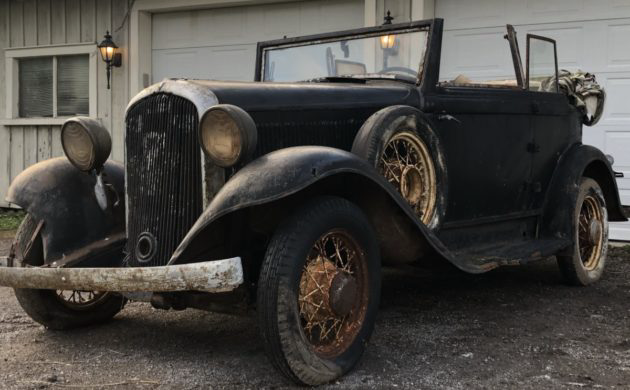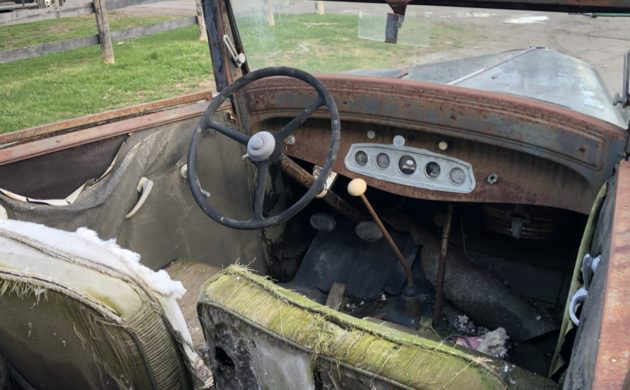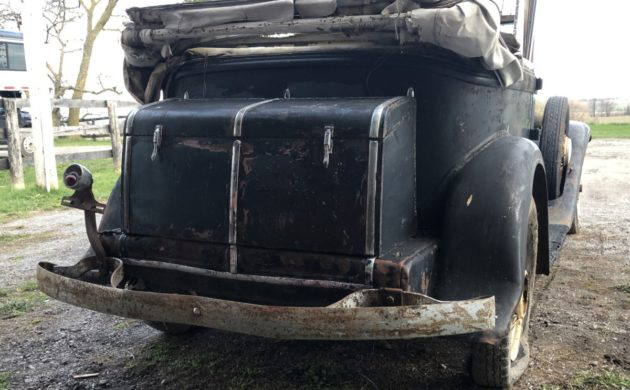When the Plymouth brand was launched by Chrysler in 1928, it is said that Henry Ford told Walter Chrysler that it would send him on the road to bankruptcy. Ford firmly believed that his company and Chevrolet had the budget end of the market firmly sewn up and that it would be impossible for Chrysler to secure a market share that would be significant enough to justify the initial investment in this new marque. As it turned out, it took only four short years for Chrysler to have the last laugh. By 1932, the country was in the depths of the Great Depression, and every marque had lost ground in the sales race…except Plymouth. This was the only brand to experience sales growth during 1932, meaning that Walter Chrysler’s faith in the brand had proven to be well-founded. This particular 1932 Plymouth Convertible Coupe is a complete car that is in need of a full restoration. It is structurally sound and is the sort of vehicle that has the potential to make a great parent/child project. It is located in Buffalo, New York, and Reader Kyle E listed for sale here on Barn Finds classifieds. The little Plymouth can be yours for $8,500.
The first thing that I noticed with this Plymouth is just how straight the vehicle is. I mean, it is an 88-year-old car, so there are bound to be some dings and dents, but these are surprisingly few and far between. The second thing that I noticed was the lack of rust. There is surface corrosion, but even this isn’t severe. It’s also nice to note that not only does the car still sport its original wire wheels, but both of the spares remain in place. The top is about as shredded as you would expect from a convertible that has been in long-term storage, but the top frame appears to be intact and suitable for restoration. The body timbers are also said to be sound, while it would seem that the chassis is also free of any problems. One other really positive aspect is the fact that not only is all of the external trim still present, but the finely-finned grille looks like it has escaped damage over the past eight decades. There is no doubt that this is a car that will require a full, nut-and-bolt restoration, but one of this model’s greatest strengths when being considered as a project car is its elegant simplicity. Chrysler designed the Plymouth to some pretty heavy cost constraints. This meant that it was a marque that had to be easy and cheap to build, and easy to maintain. It is this philosophy that makes them such a strong restoration candidate because the vast majority of the work that will be required to return the car to its former glory can be undertaken in a home workshop. That is also the reason why they make such an excellent family project.
The interior of the Plymouth is complete, but once again, a full restoration will be required. With so many painted surfaces, the majority of the work is going to be fairly straightforward. Sourcing “over the counter” interior trim might present a bit of a challenge, but prospective restorers shouldn’t find themselves deterred by this. A good upholsterer should be able to create everything that you would need, and given the general sparseness of the upholstered surfaces, this needn’t be an expensive undertaking. Alternatively, if the next owner has someone in their household who is a dab hand with a sewing machine, they might be able to produce something very attractive “in-house.” Potentially the most expensive single item to restore would be the gauge cluster. It is complete and original, but it will require specialist attention if the gauges are to be made to work accurately and reliably. However, given how inexpensive the rest of the interior refurbishment has the potential to be, it should be well worth the effort and cost to do this job properly. There are no engine photos, but we know that the engine bay houses a 196ci flathead 4-cylinder engine, which, in its prime, produced 65hp. This is backed by a 3-speed manual transmission, while the Plymouth also features 4-wheel hydraulic brakes. It was from a mechanical perspective that the Plymouth was a groundbreaking car. These were a car that was aimed at the budget-conscious motorist. Mechanical refinements such as hydraulic brakes, cast aluminum pistons, and full-pressure engine lubrication were all features that were normally the preserve of far more expensive brands. It also benefitted from a mechanical innovation that the company referred to as “Floating Power.” Sounds exotic? It was little more than the introduction of rubber engine mounts. Previously, owning any 4-cylinder car meant putting up with the tooth-rattling sensation provided by an engine bolted solidly to the vehicle’s frame. By introducing rubber mounts, the Plymouth’ engine was insulated from the rest of the car and provided the vehicle with class-leading levels of smoothness and refinement. The engine in this Convertible doesn’t currently run, but it is complete and does turn freely. Once again, these are a pretty simple piece of machinery, so returning the engine to a running state might not be a particularly difficult task.
As a project car, this 1932 Plymouth Convertible Coupe has a lot to commend it. These are such a simple and uncomplicated piece of machinery that they can be the perfect candidate for a family project, or for the first-timer who wants to dip their toe into the classic car restoration experience. The fact that this one is so complete and so solid is an added bonus. In 1932, Plymouth managed to sell an impressive 186,106 cars, but of this total, a mere 4,853 were Convertible Coupes the same as this vehicle. That makes this a relatively rare car, and of those original cars, it isn’t clear just how many have survived to this day. This particular car could so easily have disappeared into oblivion, but now there’s a chance that someone can give the car a new lease on life. I hope that someone does because I think that it deserves it.






I have to wonder when this Plymouth was stored away. I’d hedge a guess it was probably back in the early 50’s perhaps? A great find in any case! And very complete.
I think January 19th, 1962.
What do I win if I get it right?
You WIN !!!
2 silver fox traps
a Steam Piano
a bent dipstick for a ’29 Ford
and
a one way ticket to Nome Alaska to spend Christmas Day.
(all prizes must be accepted intact and NOT on a day your choosing)
Steam pianos rule. I used a blue one for my first recital.
I hope someone buys this that appreciates how rare it is. For the record Walter created both Plymouth and Desoto in 1928 and bought Dodge Brothers for $172 million dollars AND kept the Chrysler brand going. He had a big pair.
And hydraulic brakes !
This is an American Classic ….Hope someone restores it
Great find! deserves a quality restoration. I believe this is a convertible sedan one of only 690 built in 1932 and sold for $785.00 (FOB Detroit)
This is a Convertible Sedan, and not a Convertible Coupe as advertised. Any 1932 Plymouth PB is fairly rare since it was only a partial-year production run, but the Convertible Sedan is by far the rarest of any 1932 Plymouth PB body style. Only 695 were produced. (I had a PB rumble seat coupe and only saw one other on the road in the years I owned it.) The fact that the body on this car is straight, top bows are in place, and rear windows seem to be present, makes it a screaming bargain. It’s one of those rare instances where the purchase price plus restoration could end up less than the car is worth. Unless no one is paying attention, this sweetheart should be gone by tomorrow. If I had the space I would own it already.
“it isn’t clear just how many have survived to this day.”
The seller claims 19 of these are identified by serial # by the car marque collector club.
A concourse/trophy style restoration would be insanely expensive and this marque/model will never command a big $$ value.
But a good sympathetic return to a driver, is going to be affordable and give the owner who can do a fair work amount at home a wonderful car, not commonly seen and a huge source of pride and joy.
Most of These 1930’s vehicles are rolling style and class and provide plenty of smiles along the road.
Maybe a resurrected Plymouth could save Chrysler again today. America needs great small affordable cars. I miss Plymouth.
Wow, the wife and I really enjoyed watching you on Jeopardy!
Great write up Adam. This is a fantastic looking car and I have never seen one in the metal. Not every restoration needs to be a money making endeavor. Sometimes just doing something worth doing and greater than yourself is the reward. This Plymouth is a great opportunity, hope it lands in the proper hands and one day I get to see it at some obscure car show.
I own a fairly radical custom that started out as a1932 plymouth PB business roadster done probably around 1940. You can see it at dudleysportster.com. This car being so original, and an unusual model, would be a great car to fix up and drive!
I’d freak-out if someone rodded this!
Ouch. The mere mention …
This car is a convertible victoria (two doors) – although the factory often called it a convertible sedan (four doors). And yes, it is one of 19 in existence of the original 690 built. This car was built on April 15, 1932, so its just had a birthday. There is also one known existing 1932 Dodge DM convertible sedan – the DM series was built on the Plymouth drive train so Dodge could sell a less expensive 4-cylinder car in export markets. This car has been on our radar screen for many years. There is another PB convertible sedan in Canada that has just recently been professionally restored. Definitely a car you won’t meet yourself coming and going. Hopefully it goes to a good home that will properly restore it to its former glory.
Terrific write up. So much optimism and enthusiasm over a worth build.
first off lets clear one thing up there is no wood in a plymouth body , its all steel, #2 this plymouth in the day was 40 miles ahead of a 32 chev woodpile, and same with a 32 ford that every body goes ape poop over, for instace 4 wheel juice brakes, open drive shaft, pressure cooling system, and that 4 cylinder motor was used in millions of portable arc welders, farm tractors, construction machinery and more! my father was a durant car dealer,sold rogers majestic fridges, and deforest crosley parlour radios on the side he used to tell me next to durant dodge and plymouth cars were the best cars going, he also sold whippet cars and built buck rakes for farmers
What a nice looking old Plymouth . A nice write up and great comments from everyone. Now this is something I,d like to work on or anyone who would take their time and do it right. I hope some keeps it original and does a great job on it. Thank you all.
I sold Plymouths for several years in the ’70’s-just nice affordable cars. I miss them too. Someone, please save this rare old car. It deserves to see the road again.
When I was in elementary school in the fifties our school janitor had a 32 Plymouth 4 door touring car parked in his front yard. The thing about it was it had a factory radio in the dash. I’d seen a lot of cars from the 30’s but I think it was the only one I ever saw with a radio. The janitors wife (who was a good artist) told me their son owned the car, but was living in Chicago, a fer piece from Redding, California where we lived, and planned to restore it someday. Someday never came, the janitor and his wife both passed away in the 70’s and the car went to the scrap yard. It was a very rare car. Sure wish I could’ve got it.
God bless America
Reminds me of a Model A-400 Ford.
You have to be kidding..45 years in the old car biz, this is memories only! And most of those cats are selling their collections ! Find one that’s a driver for 15 or 20k at an auction and pass on this yard art!
Jim Benjaminson (above) is the expert and probably recognise me.
I have one of the export DM Dodges – six-window, 4-door sedan. It exported in CKD form through Canada to the Commonwealth countries to avoid taxes or duties. It was sold in without the body but had cowl & fenders. However, the grill is the earlier 31 PA type but bumpers & lights are the same. Dash is also the earlier type but the same outside swirl shape. My DM body was made in Adelaide, South Australia by the TJ Richards company which later became Chrysler Australia. The write up above mentions a wood body but I thought the US cars were all steel but the Australian cars were wood & steel skin.
Interesting differences between the DM & PB are a different engine number series but all the bolt heads on the car are marked DB. This would indicate they went down the production line as two different vehicles at least with different buckets of bolts.
The car was optioned (I think) with vacuum clutch and freewheel. The gearbox has n synchromesh but with the vacuum clutch & freewheel gear changes can be smoothly made. The only problem with this model is that all the adjustments are fixed and the gear changing and starting from stationary have to be the same. In the next year (DP model) a pendulum valve that varies the vacuum with the acceleration force was fitted.
The floating power engine uses two engine mounts only. One at the back of the gearbox and one under the water pump. If a line is drawn between the two it forms an axis with equal mass on either side. The engine torque is resisted by a small leaf spring on the side of the engine. When you see the engine rock you would think it needs new mounts but it is in fact normal.
Excellent find and great restoration project. Please keep it stock.
It really burns my tires when flippers buy a car $780.00 then try and flip it 80 years later for ten times the amount they paid for it! :>(
Nice…..
Put good rubber on it, and make it mechanically capable for local car shows. It’ll attract more attention than the $100K restorations.
What a little sweetheart! I agree with most of you, I hope she gets restored. I have neither the time, money or knowledge for this one myself, but she sure is deserving of the right home. Good luck to all parties involved, buying and selling.